Medieval castles in Dresden have vibrant tales of their past. Conveniently located within walking or short driving distances, these castles have turned into hotels, vineyards, museums, or private residences. Their magnificent gardens and panoramic views of the Elbe rivers, along with their rich histories, have increasingly drawn tourists in recent years.
The castles in Dresden serve as prime destinations for day trips when visiting Dresden. As a cultural, educational, and political hub of Germany and Europe, they narrate diverse stories spanning from the city’s early history through to modern times, including its experiences during the Second World War, the post-war period, and the post-reunification era.
The castles in Dresden are as follow:
- Dresden Residential Castle (Taschenberg 2, 01067 Dresden)
- Albrechtsburg Meissen (Domplatz 1, 01662 Meißen)
- Lingner Castle (Bautzner Str. 132, 01099 Dresden)
- Eckberg Castle (Bautzner Str. 134, 01099 Dresden)
- Pillnitz Castle (August-Böckstiegel-Straße 2, 01326 Dresden)
- Moritzburg Castle (Schloßallee 1, 01468 Moritzburg)
- Albrechtsberg Castle (Bautzner Str. 130, 01099 Dresden)
- Wackerbarth Castle (Wackerbarthstraße 1, 01445 Radebeul)
- Fortress Königstein (Am Königstein, 01824 Königstein)
- Wachwitz Castle (Wachwitzer Weinberg 15, 01326 Dresden)
Dresden Residential Castle (Residenzschloss)
Background
One of Dresden’s important landmarks is the Renaissance Residential Castle in the heart of the old city centre. For over seven centuries, it served as the residence for the Electors and Kings of Saxony from the House of Wettin. This medieval stronghold, one of Dresden’s oldest buildings, was expanded in the fifteenth century, transforming into a four-winged fortress. Subsequent extensions in the sixteenth century infused it with Renaissance charm. It features an eclectic mix of architectural styles, from Baroque to Neo-renaissance.
During the devastating bombing of Dresden on February 13, 1945, much of the castle lay in ruins, with only its roofless shell remaining. Restoration began in the 1960s and was completed in 2013. Today, the castle is a sprawling museum complex. It houses treasures such as the Historic and New Green Vault, the Numismatic Cabinet, the Collection of Prints, Drawings, and Photographs, and the Dresden Armory with the Turkish Chamber. Additionally, it has an extensive art library containing approximately 260,000 volumes of specialised literature on art history.
Tour
You can book the Semperoper and Old Town Tour, which allows you to admire the impressive castle and explore one of the most beautiful and culturally significant opera houses globally, the Semperoper. Afterwards, take a leisurely stroll around the charming old town of Dresden.
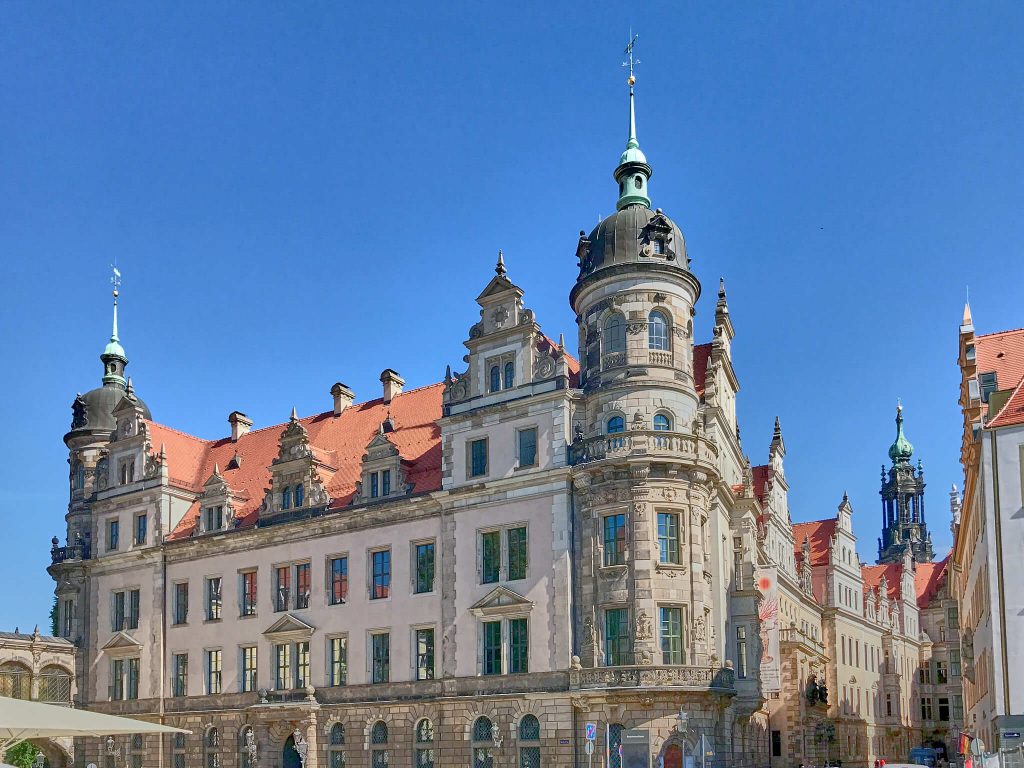
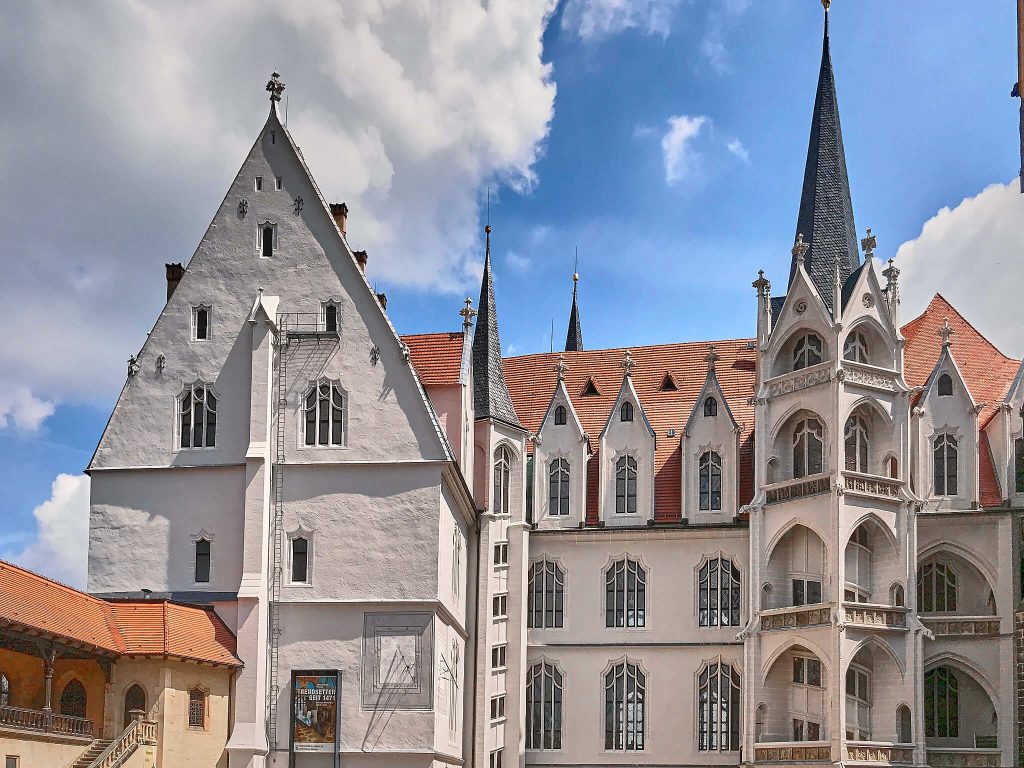
Albrechtburg Castle (Albrechtsburg Meissen)
Background
Albrechtburg Castle, commissioned by the ruling brothers Ernest and Albert of Wettin, graced Saxony’s skyline from 1471 to 1524. Unlike traditional fortresses, it served primarily as an administrative hub and regal residence.
However, its original purpose remained largely unfulfilled. Occasionally, it hosted receptions or hunting soirees, but mostly lay dormant. In 1710, Augustus the Strong ingeniously repurposed it as Europe’s inaugural porcelain manufactory, crafting Meissen porcelain within its walls for 153 years. Later, extensive restoration began to reclaim its Gothic appearance and repair the wear and tear from its industrial stint.
Constructing the castle posed challenges, with the steep riverside necessitating a two-storey basement, followed by ground and upper floors. The grand spiral staircase, an architectural marvel, showcases intricate Gothic ornamentation. Inside the castle, ornate murals dating back to 1893 depict historical events closely tied to the castle’s rich heritage.
Today, the castle welcomes visitors, offering access to all its floors. Its comprehensive exhibition, spanning five sections, demonstrates its rich history and cultural significance.
Tour
It’s convenient to take an Elbe river cruise from Dresden to Meissen. There, you can explore attractions such as the Albrechtsburg, wander through the town, and visit either the town museum or the porcelain factory. Afterward, you can easily return to Dresden.

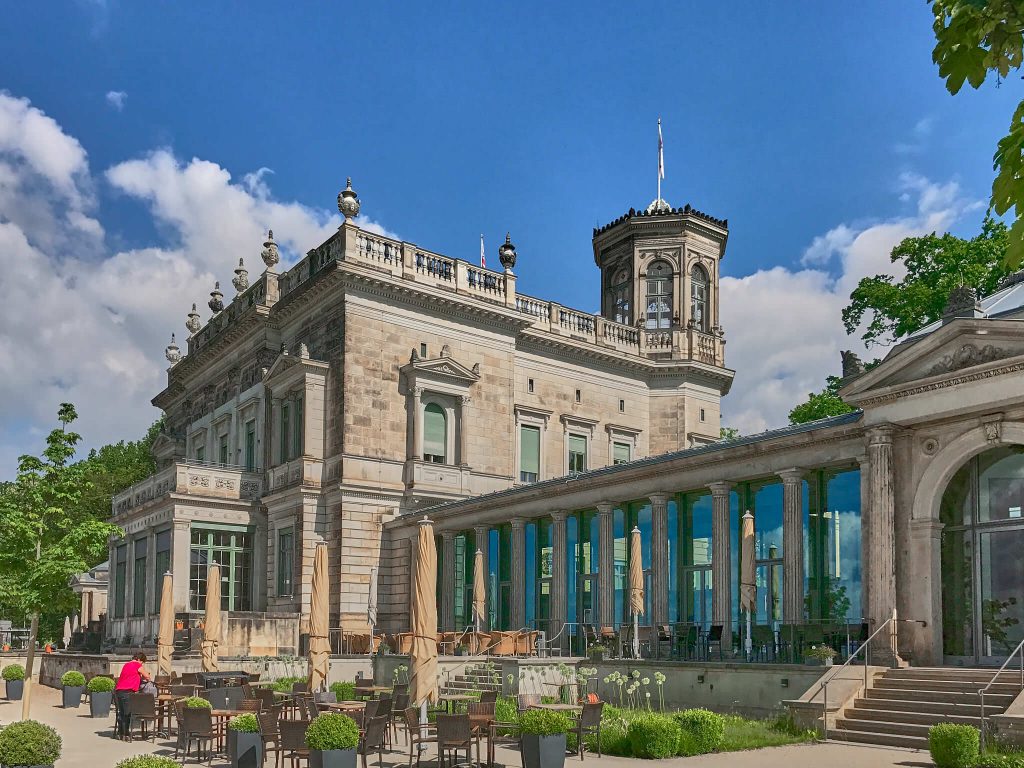
Lingner Castle (Lingnerschloss)
Designed by Prussian architect Adolf Lohse and finalised in 1852, Lingnerschloss was commissioned for Baron von Stockhausen, chamberlain to Prince Albrecht of Prussia, who resided in Albrechtsberg Castle nearby. Sadly, the Baron passed away shortly after its completion.
Subsequent owners included industrialist Bruno Naumann, before entrepreneur Karl August Lingner, creator of the renowned “Odol” mouthwash, took possession in 1906. Lingner made some changes, including the installation of a cable car from the castle terrace to the vineyard in 1908. However, this was demolished in 1933.
Upon Lingner’s death in 1916, ownership transferred to the city of Dresden. It served various purposes over the years, from a children’s home and educational facility in the 1930s to an auxiliary hospital during World War II, and later, under Soviet military administration.
From 1955, it became the prestigious venue for the “Dresdner Club”, hosting the city’s intellectual elite. In 2002, Förderverein Lingnerschloss e.V. was established to restore and preserve the castle. Today, the castle hosts a multitude of events, offering a stunning view of the Elbe river and the iconic “Blue Wonder” iron bridge from its picturesque terrace.
Tour
Enjoy a relaxing boat cruise along the Elbe, ideal for couples or the entire family. Experience the picturesque views of Albrechtsberg Castle, Eckberg Castle, Lingner Castle, and the iconic Blue Bridge along the way.

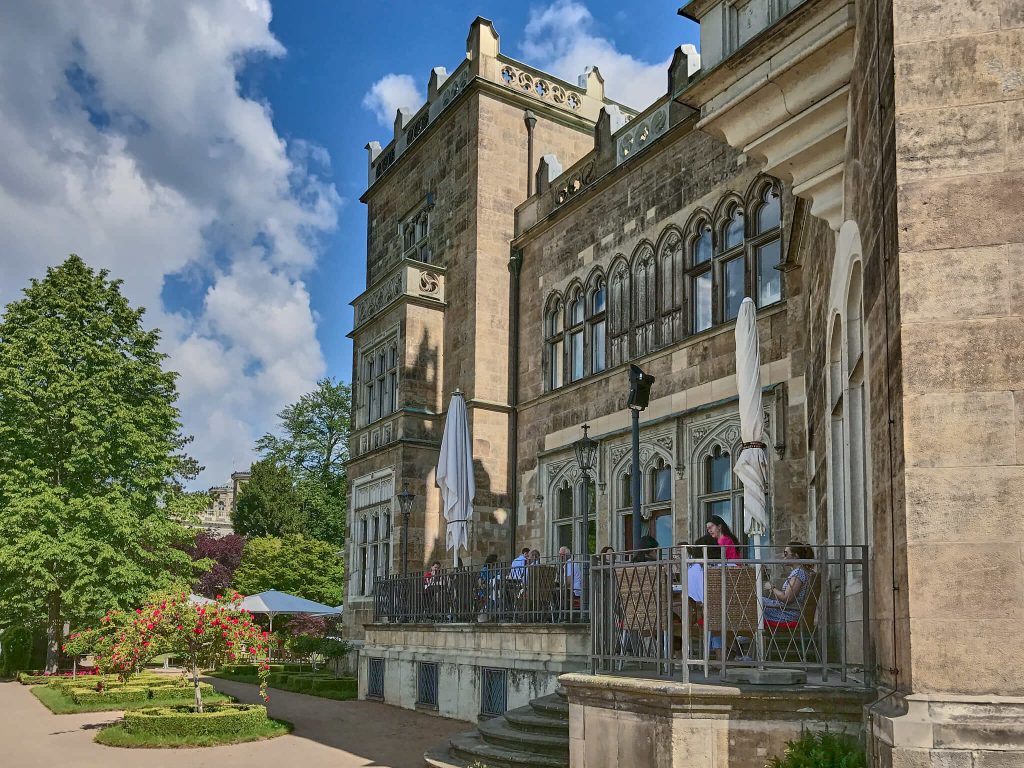
Eckberg Castle (Schloss Eckberg)
One of the other medieval castles in Dresden is Eckberg Castle. In 1858, merchant Johann Daniel Souchay from Manchester acquired the “Eckberg” vineyard. Envisioning an English mansion in Neo-Gothic style, he enlisted Prof. Christian Friedrich Arnold for the project. Shortly after, the castle, park, and surrounding buildings were completed, offering Souchay a fairy-tale estate until his demise in 1871.
In 1883, heirs sold the estate, leading to multiple changes in ownership. Fast forward to 1925, when Ottomar Heinsius von Mayenburg, inventor of the aluminum tube and Chlorodont toothpaste, realised his lifelong dream of transforming Schloss Eckberg. A botanist at heart, he devoted himself into the transformation of the park, including a rock garden, rose wall, and flower meadow.
Following the Mayenburg family’s expropriation in 1952, Eckberg Castle saw various uses, from a dormitory to a trade union school, and later, an electronics manufacturing site. The 1990s saw a resurgence of interest in East Germany’s historical sites, prompting renovations. Eckberg Castle became the Youth Tourist Travel Association.
Post-German reunification, the von Mayenburg family regained ownership. However, they sold the property to Munich-based company group ARGENTA. From 1996 to 1997, extensive renovations transformed the castle and its surroundings into a luxury hotel complex. You can now book a room at Hotel Schloss Eckberg. It is one of the Dresden’s luxury yet affordable historic hotels.
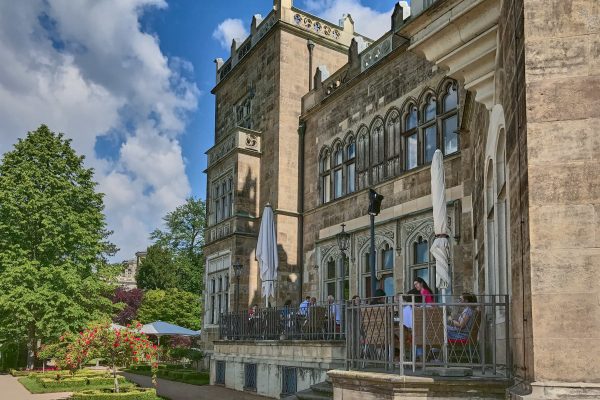
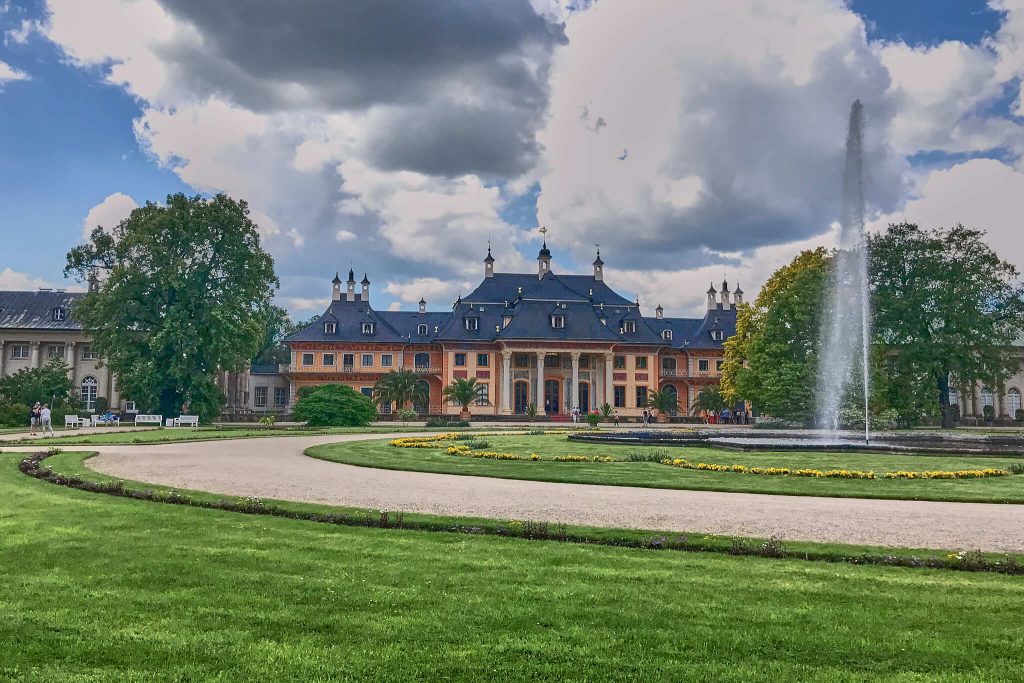
Pillnitz Castle (Schloss Pillnitz)
Pillnitz Castle is a beautifully restored Baroque palace, once cherished as the summer retreat for Saxony’s royalty. Originally, a modest fortress occupied this site in the 14th century, but in 1715, it underwent a transformation into an exotic oriental palace, perfect for riverside festivities.
Comprising three primary structures—the Riverside Palace, Upper Palace, and the later Neoclassical New Palace—the Pillnitz Castle complex is set within a sprawling Baroque garden, encircled by a vast public park. Notably, the upper staircase, constructed in 1722, was later complemented by water stairs in 1725, creating a picturesque gondola dock along the Elbe.
Pillnitz Castle distinguishes itself with its extensive 28-hectare park, adorned with an English pavilion, a charming Chinese pavilion, and a Palm House. A tranquil 500-metre chestnut-lined alley runs parallel to the riverbank, flanked by neat hedged parterres. At the heart of the Baroque flower garden lies a magnificent fountain. Besides, it also features botanical treasures from all over the world.
Tour
You can take the Elbe river cruise aboard a vintage paddle wheel steamer to reach the castle. Departing from Terrassenufer in the old city centre, the cruise passes by three renowned castles in Dresden and five famous Elbe bridges. Afterward, you can partake in a 1.5-hour guided costumed tour of Pillnitz Castle with Countess von Brühl.

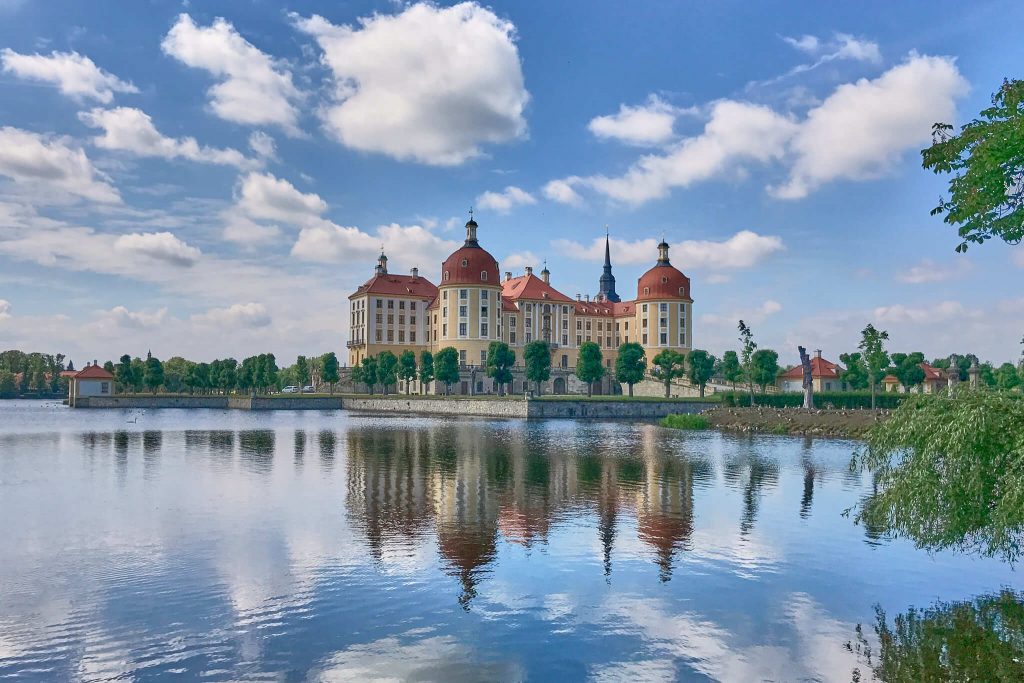
Moritzburg Castle (Schloss Moritzburg)
Moritzburg Castle, also known as Moritzburg Palace, is a Baroque masterpiece with four round towers atop a symmetrical artificial island. Originally a hunting lodge, it gradually expanded over the centuries under various residents’ care.
Step inside, and you’ll be greeted by opulent Baroque decor, with walls covered in 17th-century gold-gilded leather. A highlight awaits in the dining room: the world’s largest collection of red deer antlers, including the heaviest specimen ever recorded. The other collections are, for example, porcelains from China, Japan, and Meissen. However, the most eye-opening piece is the four-poster bed, which had approximately a million peacock, pheasant, guinea hen, and duck feathers woven into the canvas, commissioned for Augustus the Strong’s Japanese palace. Don’t miss the impressive display of royal carriages in the entrance hall.
Outside, the castle’s U-shaped park spans approximately 230 by 150 meters, designed in the French style. Though left incomplete due to Augustus the Strong’s passing, it offers enchanting walks along an eight-arm, star-shaped network of forest paths. The nearby Little Pheasant Castle, with its miniature harbour and Saxony’s sole lighthouse, is worth a visit as well.
Tour
Explore Moritzburg on an exhilarating scavenger hunt, discovering the town’s highlights in a unique and playful manner. Solve puzzles and encounter attractions such as the castle, the lighthouse, and the game reserve, among others.

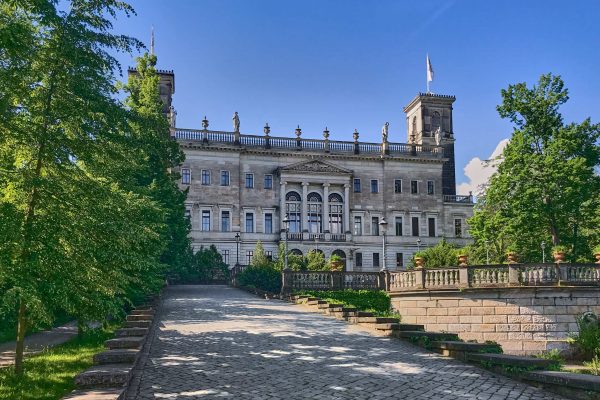
Albrechtsberg Castle (Schloss Albrechtsberg)
In 1853, Prince Albert of Prussia faced a challenging situation due to his morganatic marriage, leading him to depart the Prussian court. Seizing the opportunity, the wife of his chamberlain acquired the idyllic “Findlater’s Vineyard” from Scottish nobleman James Ogilvy, along with the manor and its gardens. The castle underwent a lavish renovation, adopting a late Neoclassical style. Marble, the most kingly wood and the white sandstone from Saxony were used for the interior design. Outside, the landscape of the garden includes curved alleys, bridges, a viaduct, ponds, rocks, and a waterfall. The prince couple moved in 1854 when the castle construction was complete.
Following the passing of Prince Albrecht and Rosalie, their younger son Count Frederick of Hohenau resided in the castle until his death. Subsequently, his elder brother Wilhelm assumed ownership. However, in 1925, Wilhelm was compelled to part with the castle and its grounds, owing to substantial gambling debts. The city of Dresden acquired the property, but it changed hands again in 1948, this time to the Foreign Economic Trade Ministry of the Soviet Union. Yet, in 1951, East Germany reclaimed ownership, returning the castle to Dresden’s possession.
Since its designation as a historical monument in 1977, ongoing restoration continues to the present day. Today, Albrechtsberg Castle serves as a private hotel and catering school. Furthermore, it features elegant halls, sumptuous saloons, and a sun patio.
Tour
Albrechtsberg, Eckberg, and Lingner Castles in Dresden are landmarks in Dresden’s suburb, conveniently close to each other and easily accessible on foot. Additionally, the Elbe River Cruise to Pillnitz Castle offers a delightful opportunity to behold these three castles along the way.

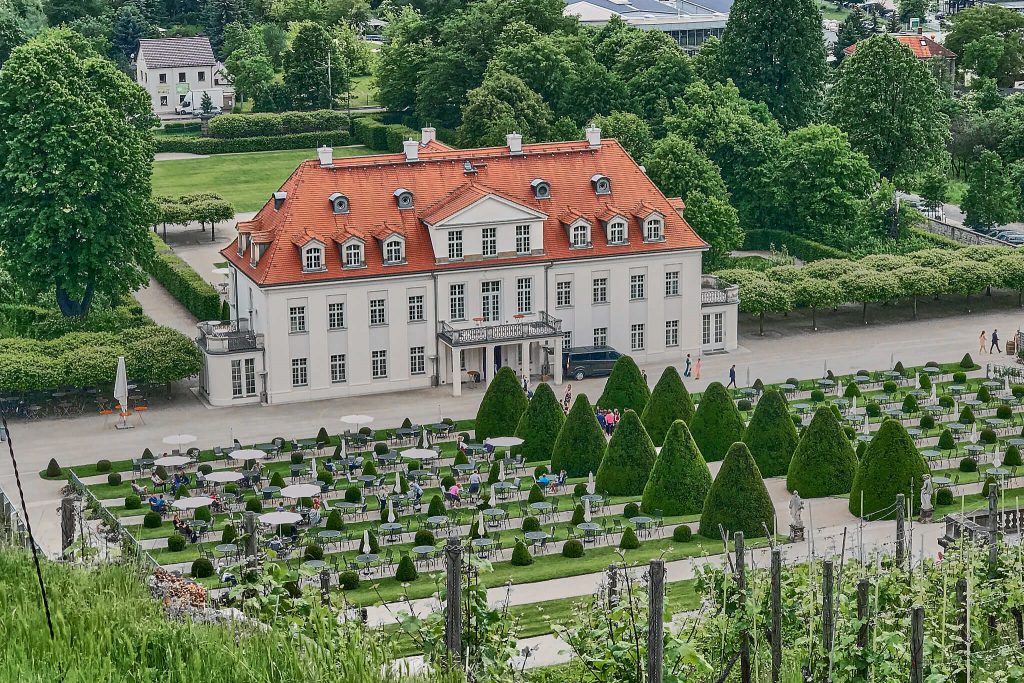
Wackerbarth Castle (Schloss Wackerbarth)
Below a large vineyard, the castle, erected between 1727 and 1730, was the home of August Christoph von Wackerbarth in his retirement. Following his passing, the castle changed hands several times until 1808, when Raugraf August Josef Ludwig von Wackerbarth, a descendant of the original builder, assumed ownership. However, it slipped from his grasp in 1816.
Over the years, the castle assumed various roles, such as a school, retirement home, residence, and hospital. In 1952, it was reincarnated as a winery under Volkseigene Gut ownership. Extensive renovations took place between 1974 and 1977, restoring the castle and parts of its garden. By July 1990, it was rebranded as Weinbau Radebeul GmbH, becoming Saxony’s premier state vineyard. The inaugural summer night ball, attended by Rüdiger Freiherr von Wackerbarth and his wife Adelheid as esteemed guests, marked a significant milestone.
Today, the castle and its resplendent Baroque gardens are popular places for locals to taste wines, offering delightful wine tastings, hosting events, and orchestrating memorable wedding celebrations. Outside, beneath the vine-clad terraces, tables with parasols attract visitors with its charming Baroque garden ambiance.

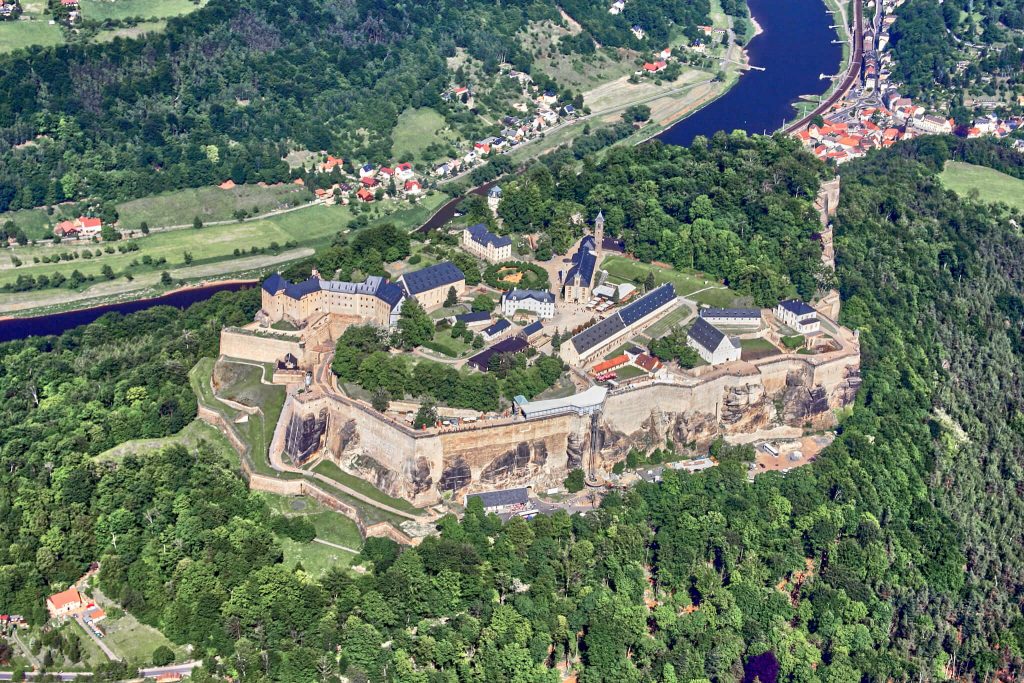
Fortress Königstein (Festung Königstein)
Perched above the quaint town of Königstein, on the picturesque left bank of the River Elbe, lies the Königstein Fortress. Spanning an area equivalent to 13 football pitches and towering 240 metres above the river, it ranks among Europe’s largest hilltop fortifications. With over 50 buildings, some dating back more than four centuries, its sprawling complex tells tales of bygone eras.
The castle’s storied history dates back to 1233 when it served the Kingdom of Bohemia. Today, the oldest surviving structure is the castle chapel, a testament to the medieval craftsmanship of the early 13th century. Noteworthy is the construction of the 152.5-metre-deep well, bored into the rock between 1563 and 1569.
Throughout its history, Königstein Fortress host prisoners of war during conflicts like the Franco-Prussian War and both world wars. Numerous prominent prisoners incarcerated at Königstein. Post-World War II, the fortress found new purpose as a military hospital for the Red Army.
Today, accessing the fortress is easy with lifts and panoramic elevators. Visitors can explore fascinating sites such as the first Saxon garrison church, Augustus the Strong’s colossal wine barrel, and various exhibitions. A highlight awaits atop the fortress, offering breathtaking panoramic views of the Elbe Sandstone Mountains, drawing visitors from across the globe. It is at the opposite of Bastei Saxon Switzerland National Park.
Tour
To reach Königstein Fortress, consider taking a cruise along the Elbe aboard a charming paddle steamer. As you journey along the riverbanks, you’ll have the chance to admire the majestic Bastei rock formation in Rathen.
Wachwitz Castle
Perched above the former royal vineyard of Wachwitz in Dresden, lies Wachwitz Castle. Originally acquired by Crown Prince Friedrich August II in 1824, it served as his idyllic summer retreat. Later, in 1892, the palace underwent demolition and reconstruction to become the summer residence of Crown Prince Friedrich August III and his family. The present-day castle, constructed between 1936 and 1937, stands atop the former royal mansion and was once the esteemed abode of Friedrich Christian of Saxony from the illustrious Wettiner family, until the upheavals of 1945 led to the Wettin’s expropriation.
Following World War II, the castle witnessed diverse roles, serving as the administrative hub of the Soviet Military Administration and later transformed into an “Intourist Hotel” by the Soviet travel agency from 1947 to 1949. Subsequently, it became a branch of the youth college “Wilhelm Pieck” until 1990, before transitioning into a conference center and guest house for the Medical Academy Dresden from 1990 to 1993.
The castle lies on an approximately 27-acre area at the Wachwitzer Höhenpark. Whether it’s the blossoming beauty of spring, the bountiful grape harvest in autumn, or the serene snow-covered landscapes of winter, the historic buildings, vineyards, and park are popular in every season. While the area is now predominantly used for apartments, the rhododendron park nearby and primary hiking trails remain accessible to the public.
How to get to Dresden
If you plan to explore several castles in Dresden independently, the most convenient mode of transportation is by car. The distance between Berlin and Dresden is just under 200 km, with a travel time of approximately 2 hours. Driving yourself is a practical option if you prefer not to join a guided tour.
Dresden also has its own airport, with flights operated by Eurowings and Lufthansa from various major German cities. This provides another accessible option for reaching Dresden.
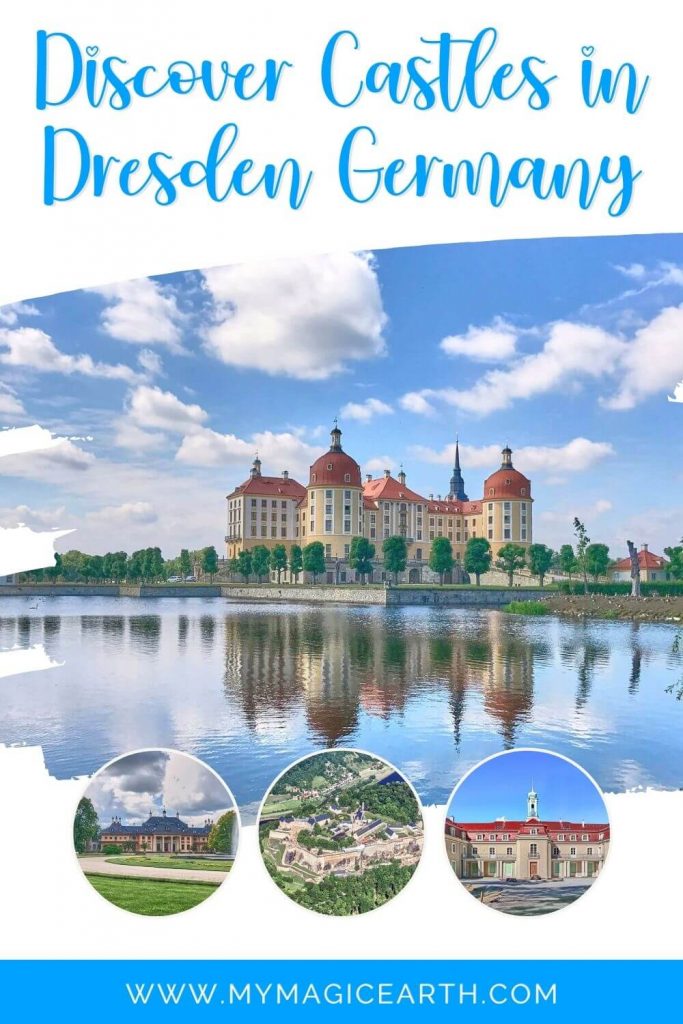
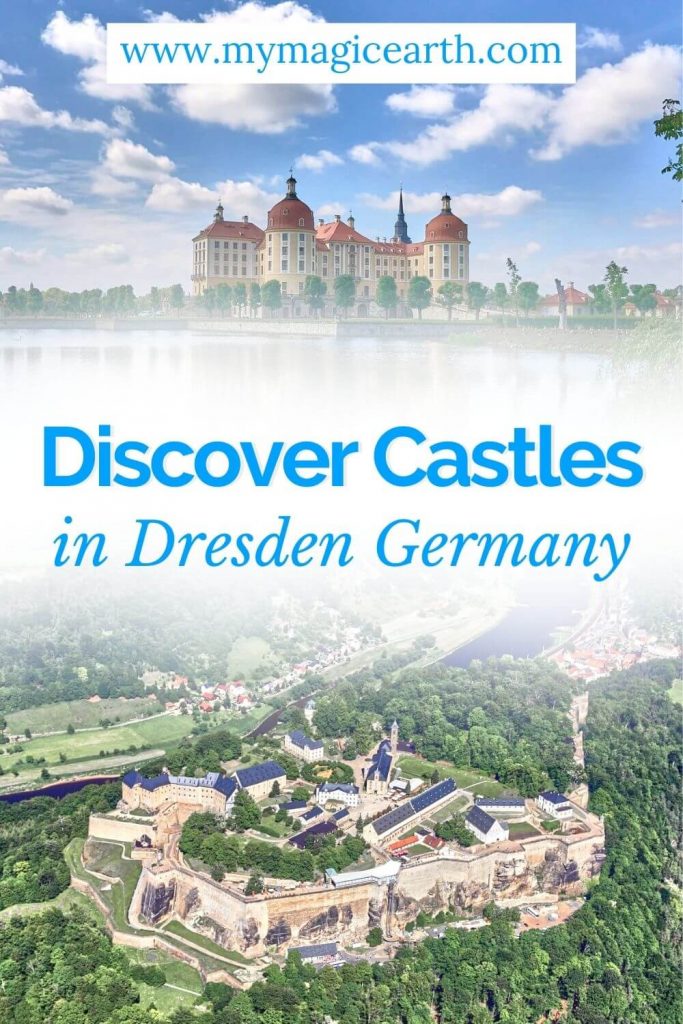
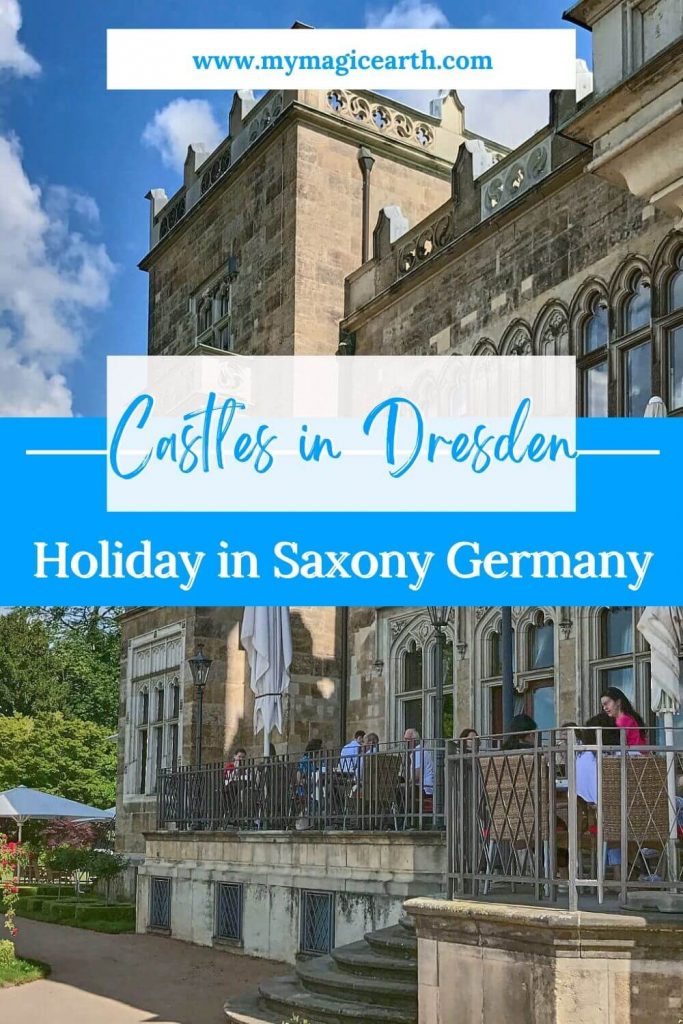



Forts and castles are my all-time favourite places to visit. Thanks for sharing this lovely list of the castles to visit in Dresden. They all look and sound so fascinating with interesting history associated with them. I can spend hours exploring these wonders.
What a detailed guide. I would love to do this tour by car as it gives ample time. Like these castles, the palaces in India have their owns tories. That’s the beauty of ancient buildings–they somehow have that larger than life and eternal feel. Fortress Königstein has gone on my bucket list for sure.
Even though a small town, Dresden sure has some amazing castles. It’s almost unreal how many beautiful castles you can see together in the same area. Lingner Castle is probably the most famous one but my personal favorite would be Moritzburg Castle
I am a castle lover and if i travel to Dresden that would be mainly for castles.I knew there were 4-6 castles in Dresden but it was good to learn about all the other ones too. My favorite is Dresden Residential Castle. Thanks for sharing your knowledge
It’s amazing to find so many castles in one area and all of them are so different. I’m also surprised to find that Dresden is a feasible day trip from Prague! Would love to be able to stay in Albrechtsberg Castle and Lingner Castle looks somewhat modern and beautiful.
I didn’t know about all these castles near Dresden. I don’t think I have even thought about the middle age in Germany! What an eye-opener article. I think my favourite would be the Albrechtburg castle because it looks like my doll castle when I was a kid! I’d love to do that costume tour too at the castle Pillnitz.
It’s amazing how many beautiful castles you can see together in the same area. I’d heard you can stay in some of them and that seems like it would be the most amazing experience! I would love to spend a night at the Eckberg. I think the Lingner Castle is the most gorgeous on the list and will have to make a trip to see it one day. Thanks for the info about the day trip from Prague. I wish I’d known about it when I visited Prague a few months ago!
Wow! Who knew there were so many Medieval castles in Dresden? Not me, that’s for sure. From the list, I’m most drawn to Pillnitz Castle, as you can also take a river cruise to reach it. The architecture of Moritzburg Castle is so unique, I wouldn’t think it was from the medieval period. I really enjoyed reading about these castles, I definitely want to visit!
Germany has the most number of castles in a country and I am not surprised to see 10 castles in one city itself -Dresden. I did not know that Dresden could be covered as only a day trip from Prague, though I am pretty sure it deserves a lot more time than that. Dresden Residential Castle and Eckberg Castle would be my top picks, if I am unable to make it to all.